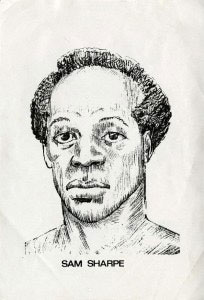
About Sam Sharpe
“I would rather die upon yonder gallows, than live in slavery.”
Inspirational words from an enslaved man, a Baptist deacon, a freedom fighter and the main instigator of the 1831 Slave Rebellion in Jamaica which was instrumental in bringing about the abolition of slavery.

Samuel Sharpe was born in Jamaica in 1801. Although he was born a slave he learnt to read and write and he educated himself by reading newspapers and books. Sam Sharpe joined the church and became a Baptist Deacon. Religious meetings were a permissible form of organised activity by slaves and Sharpe was able to use the meetings to inspire his congregations and communicate his concerns. He spoke out against the injustice of slavery and it is said that he amazed people with the power and passion of his speech.
When Sharpe was just 31 years old he instigated a plan of passive resistance, a general strike against slavery. The plan was that slaves would refuse to work after their Christmas holiday in 1831. They would continue to strike until the state owners and managers listened to their grievances. Sharpe felt that the owners might listen to the slaves as the strike was timed for the key sugar cane harvest and if the ripe cane was not cut then it would be ruined.
Sharpe hoped to inspire a peaceful resistance, indeed he encouraged the slaves to only fight physically if the managers didn’t agree to their demands. Yet Sharpe probably knew that their strike would not succeed and he made military preparations for the rebellion.
As the idea for the strike spread throughout the island to St. James, Trelawny, Westemoreland and beyond, the plan reached the ears of some of the slave owners. As Sharpe anticipated they did not react favourably. Troops were sent to St. James and warships were anchored in Montego Bay and the Black River with their guns trained on the town.
On December 28 1831, the Kensington Estate Great House was set alight as a signal that the rebellion had begun. Other fires broke out and it soon became clear that the Sam Sharpe’s hope for peaceful resistance was impossible. The rebellion lasted for 8 days and resulted in the death of around 186 slaves and 14 white overseers or planters. Retribution for the resistance was swift and merciless. Over 500 slaves were convicted and many were executed, most were hanged and their heads were cut off and placed around their plantations. Those who escaped the death penalty were treated brutally and many did not survive. Sam Sharpe was named as the key figure behind the resistance and he was captured and hanged in Montego Bay on a square now called Sam Sharpe Square. Sharpe’s owners were paid the sum of just £16.00 for their ‘loss of property’.
Sam Sharpe was hanged on May 23, 1832. He was the last person to be executed for participating in the Revolt.
‘When reminded that the Scriptures teach human beings to be content with the station [status] allotted to them by Providence, and that even slaves are required patiently to submit to their lot, til the Lord in His providence is pleased to change it, Sharpe responded, “If I have done wrong in that, I trust that I shall be forgiven for I cast myself upon the Atonement … I would rather die upon yonder gallows than to live in slavery”.’?(Henry Bleby,
Death Struggles of Slavery, 116-17)
The uprising that he had instigated was a key moment in the fight for the abolition of slavery as just a few years later, in 1834, slavery would be abolished and a system of ‘Apprenticeship’ would be instituted. On August 1, 1938 the Apprenticeship System ended and slaves were granted their freedom.
Sam Sharpe was a man of immense faith and courage and his legacy was recognised by the Jamaican authorities when he was made a National Hero in 1975.
Click the links below for further information: